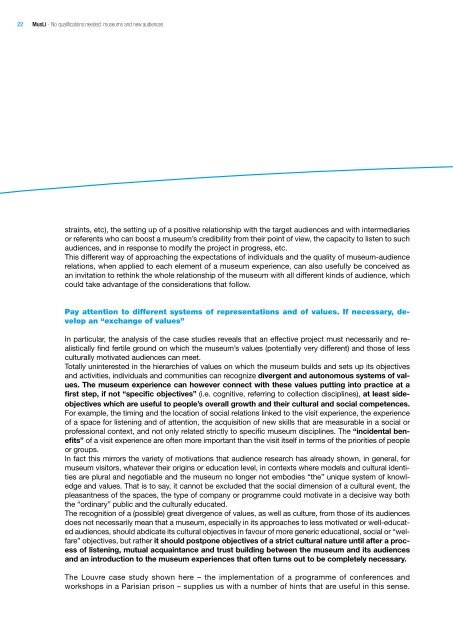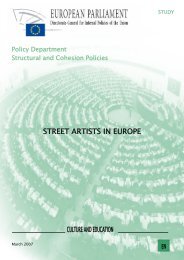MusLi (Museums Literacy) - Fondazione Fitzcarraldo
MusLi (Museums Literacy) - Fondazione Fitzcarraldo
MusLi (Museums Literacy) - Fondazione Fitzcarraldo
Create successful ePaper yourself
Turn your PDF publications into a flip-book with our unique Google optimized e-Paper software.
22 <strong>MusLi</strong> - No qualifications needed: museums and new audiences<br />
straints, etc), the setting up of a positive relationship with the target audiences and with intermediaries<br />
or referents who can boost a museum’s credibility from their point of view, the capacity to listen to such<br />
audiences, and in response to modify the project in progress, etc.<br />
This different way of approaching the expectations of individuals and the quality of museum-audience<br />
relations, when applied to each element of a museum experience, can also usefully be conceived as<br />
an invitation to rethink the whole relationship of the museum with all different kinds of audience, which<br />
could take advantage of the considerations that follow.<br />
Pay attention to different systems of representations and of values. If necessary, develop<br />
an “exchange of values”<br />
In particular, the analysis of the case studies reveals that an effective project must necessarily and realistically<br />
find fertile ground on which the museum’s values (potentially very different) and those of less<br />
culturally motivated audiences can meet.<br />
Totally uninterested in the hierarchies of values on which the museum builds and sets up its objectives<br />
and activities, individuals and communities can recognize divergent and autonomous systems of values.<br />
The museum experience can however connect with these values putting into practice at a<br />
first step, if not “specific objectives” (i.e. cognitive, referring to collection disciplines), at least sideobjectives<br />
which are useful to people’s overall growth and their cultural and social competences.<br />
For example, the timing and the location of social relations linked to the visit experience, the experience<br />
of a space for listening and of attention, the acquisition of new skills that are measurable in a social or<br />
professional context, and not only related strictly to specific museum disciplines. The “incidental benefits”<br />
of a visit experience are often more important than the visit itself in terms of the priorities of people<br />
or groups.<br />
In fact this mirrors the variety of motivations that audience research has already shown, in general, for<br />
museum visitors, whatever their origins or education level, in contexts where models and cultural identities<br />
are plural and negotiable and the museum no longer not embodies “the” unique system of knowledge<br />
and values. That is to say, it cannot be excluded that the social dimension of a cultural event, the<br />
pleasantness of the spaces, the type of company or programme could motivate in a decisive way both<br />
the “ordinary” public and the culturally educated.<br />
The recognition of a (possible) great divergence of values, as well as culture, from those of its audiences<br />
does not necessarily mean that a museum, especially in its approaches to less motivated or well-educated<br />
audiences, should abdicate its cultural objectives in favour of more generic educational, social or “welfare”<br />
objectives, but rather it should postpone objectives of a strict cultural nature until after a process<br />
of listening, mutual acquaintance and trust building between the museum and its audiences<br />
and an introduction to the museum experiences that often turns out to be completely necessary.<br />
The Louvre case study shown here – the implementation of a programme of conferences and<br />
workshops in a Parisian prison – supplies us with a number of hints that are useful in this sense.






